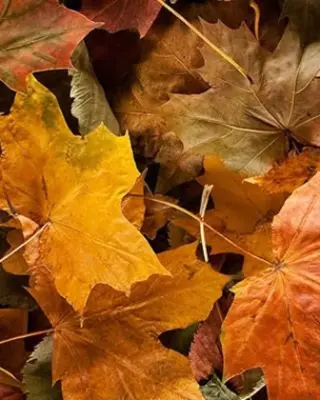
Uses for Fallen Leaves
- Hints & Tips
- Garden Blog
- Uses for fallen leaves
Leaving fallen leaves on your lawn can starve the grass of oxygen and vital nutrients, leaving your lawn patchy and discoloured. But fallen leaves can be used in a variety of ways to actually help your garden. Check out our top tips for how to use fallen leaves.
If leaves are so good why do gardeners rake them up in the autumn? Simply because fallen leaves can suffocate your grass and once wet, will create a boggy surface that may attract disease. Dried leaves might look attractive, but they block out the sun and starve your grass.
Wet fallen leaves make pathways slippery and don’t look very appealing. They can also block drains and gutters preventing water running away from your property. In heavy weather, this could quickly cause a flood.
In the wrong place, fallen leaves can quickly cause problems, but they do have some uses that can help make sure your garden stays lush and green all year round. In fact, dried leaves treated correctly might rescue a dying lawn and could even insulate cold areas in your house.
Dried leaves are ideal for all sorts of jobs in the garden and are much easier (and nicer) to collect than wet leaves. Shred dried leaves to increase the surface area for microbes to get to work and then bag them for use later on either as leaf mould or as a topping for your borders. If you shred your dried leaves into small enough bits, they can be used to enrich your lawn without blocking the sunlight it needs.
Here are a few of the ways you can make use of your dried leaves this autumn.
If leaves have fallen onto your lawn, then put your Flymo rotary lawn mower on its highest cutting setting, and mow over them. This will shred them into pieces too small to rake (sometimes referred to as mulching) enabling them to break down into the lawn without blocking sunlight. This makes a great soil conditioner and helps the soil retain moisture helping it remain healthy throughout the winter.
Fallen autumn leaves are a great source of brown material for your compost bin.
The leaves should be moist and mixed with green material such as vegetable peelings and grass clippings. Compost heaps should be turned once a month to allow oxygen to circulate. Over time, the fallen leaves, combined with other garden waste, will eventually break down into a thick black compost that is rocket fuel for your plants, flowers and lawn.

If you have a large number of fallen leaves, then making leaf mulch is a great alternative to throwing them away. First, collect them up and shred them. A Flymo PowerVac 3000 is a quick and easy way to do this. This electric garden vacuum will collect even wet leaves and shred them - perfect for leaf mulch or your compost bin. You can buy a Flymo PowerVac 3000 in most retailers online or on the high street.
Once you have shredded your leaves, carefully place them around your plants and in the flowerbeds. The layer should be around 2 or 3 inches thick and should not touch the stem of any plant as this could encourage disease.
Leaf mulch has a number of benefits. It breaks down into a great soil conditioner, but it will also act as insulation for plants and vegetables. Leaf mulch also provides useful animals like worms a good habitat and shelter from predators such as birds. Leaf mulch will also act as a brilliant weed barrier preventing their unwanted growth.
Much like leaf mulch, soil amendment makes use of your fallen leaves by adding them directly to your flowerbeds. You don’t need to shred the leaves for this method to work just pile up a layer up to 6 inches deep then work the leaves into the soil with a tiller. This green matter will gradually decompose over winter, enriching your flowerbeds with nutrients. An added bonus of this method is that it aerates your soil as you dig the leaves in.
During the spring and summer months it can be difficult to find sufficient brown material for your compost bin. By storing plastic bags of fallen leaves in a cool, dry place, you will have a rich source of brown material all year round. This method is also good for producing leaf mould, a valuable resource for every gardener.
Collect as many fallen leaves as you can, dry them out and bag them up. Pack as many bags as you can tightly together and store them in cold areas of your home, like the basement or garage. These bags of leaves will act like insulation helping to keep your home warm during the winter. Come spring, you will have a ready collection of brown material for your blossoming garden.
